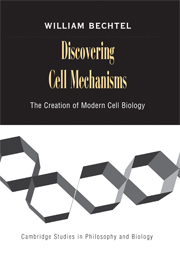Book contents
- Frontmatter
- Contents
- Preface
- 1 Introduction: Cell Mechanisms and Cell Biology
- 2 Explaining Cellular Phenomena through Mechanisms
- 3 The Locus of Cell Mechanisms: Terra Incognita between Cytology and Biochemistry
- 4 Creating New Instruments and Research Techniques for Discovering Cell Mechanisms
- 5 Entering the Terra Incognita between Biochemistry and Cytology: Putting New Research Tools to Work in the 1940s
- 6 New Knowledge: The Mechanisms of the Cytoplasm
- 7 Giving Cell Biology an Institutional Identity
- Afterword
- References
- Index
6 - New Knowledge: The Mechanisms of the Cytoplasm
Published online by Cambridge University Press: 05 June 2012
- Frontmatter
- Contents
- Preface
- 1 Introduction: Cell Mechanisms and Cell Biology
- 2 Explaining Cellular Phenomena through Mechanisms
- 3 The Locus of Cell Mechanisms: Terra Incognita between Cytology and Biochemistry
- 4 Creating New Instruments and Research Techniques for Discovering Cell Mechanisms
- 5 Entering the Terra Incognita between Biochemistry and Cytology: Putting New Research Tools to Work in the 1940s
- 6 New Knowledge: The Mechanisms of the Cytoplasm
- 7 Giving Cell Biology an Institutional Identity
- Afterword
- References
- Index
Summary
This continuous body of knowledge, which should be properly named cellular and molecular biology, could be compared to a bridge which, like its equivalents in civil engineering, has two bridgeheads: one in traditional anatomical-morphological sciences and the other in equally traditional biochemistry. The cautious and careful have stayed close to the bridgeheads because the area around them had been consolidated over centuries by the work of their predecessors. The bold and venturesome have ventured on the bridge itself from both directions, because they believed that there was where the action was going to be…. As in the old Latin proverb, fortune favored the bold: the bridge proved to be strong enough to support the intense occasionally frantic activity of whole armies of explorers.
(Palade, 1987, pp. 112–13)In the 1950s and 1960s the initial ventures into the terra incognita between classical cytology and biochemistry developed into the robust bridge Palade identified in the above quotation. In large part this involved building on the localization of cellular energetics in the mitrochondria, and of protein synthesis in the microsomes, that had been established in the 1940s by decomposing these organelles and figuring out the operations associated with their parts. I will focus principally on these developments, but in the 1950s investigators identified the function of two other organelles – the Golgi apparatus and the lysosome – and established research programs to determine how they performed their functions.
- Type
- Chapter
- Information
- Discovering Cell MechanismsThe Creation of Modern Cell Biology, pp. 190 - 257Publisher: Cambridge University PressPrint publication year: 2005



